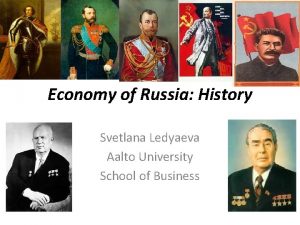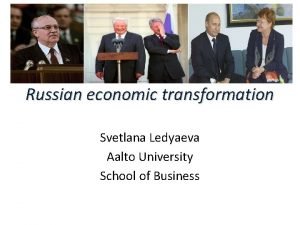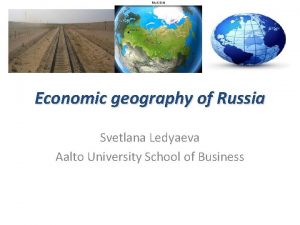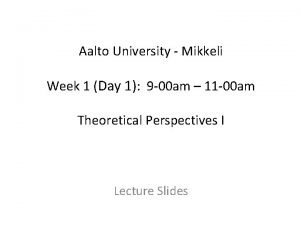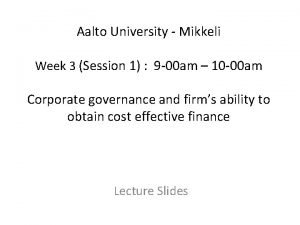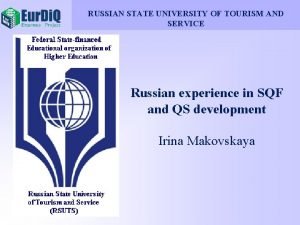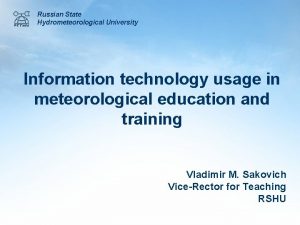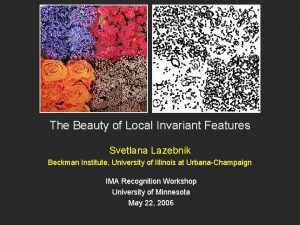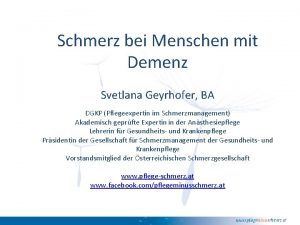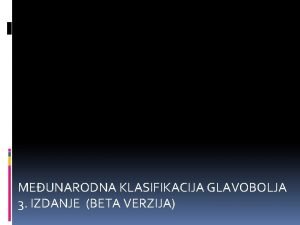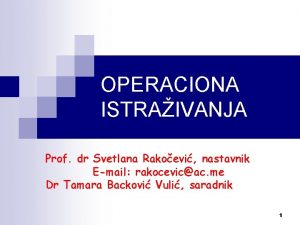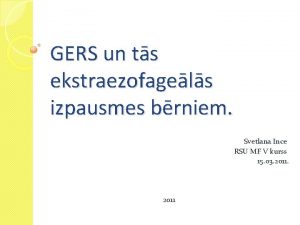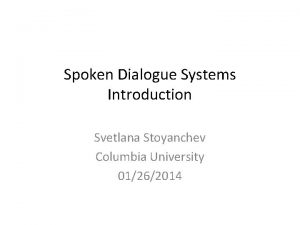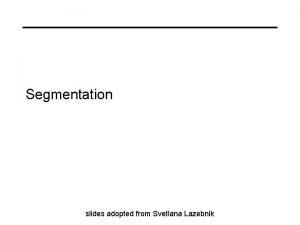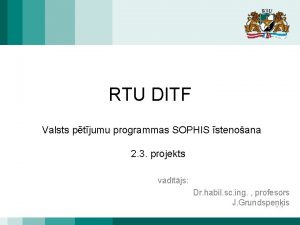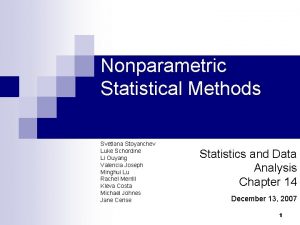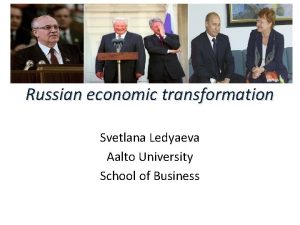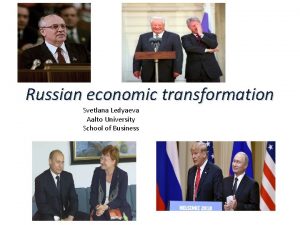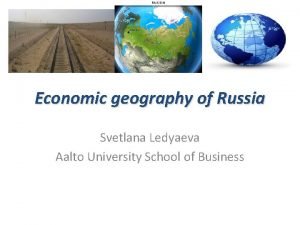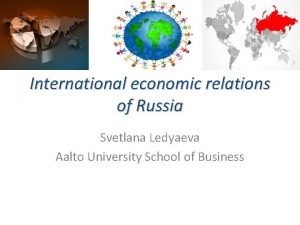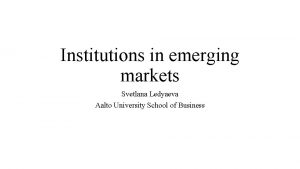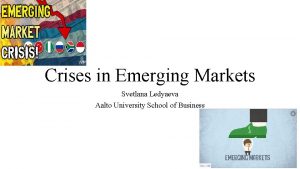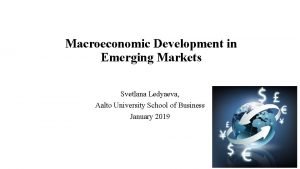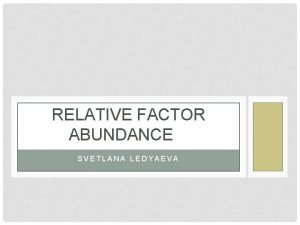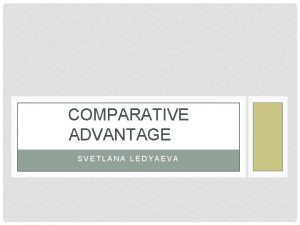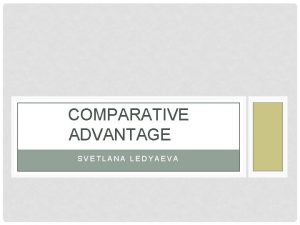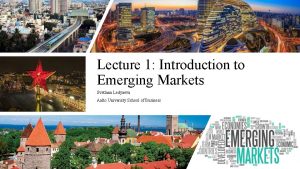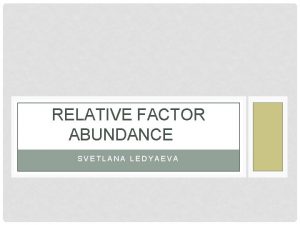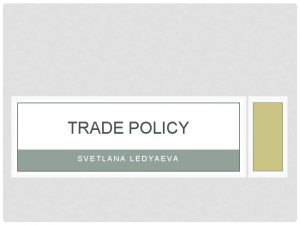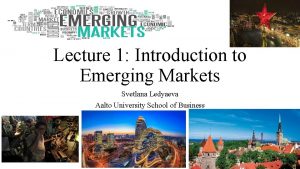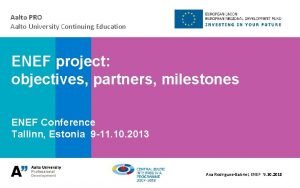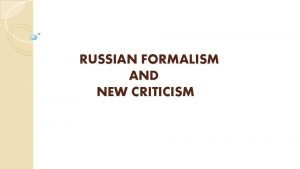Russian economic transformation Svetlana Ledyaeva Aalto University School


































- Slides: 34

Russian economic transformation Svetlana Ledyaeva Aalto University School of Business

Conclusions from previous lecture “Great reforms” of Peters the Great played important role in Russia`s economic development in 18 th century. “Great reforms” of Alexander II in the second part of 19 th century has led to significant industrialization of the Russian economy. Bolshevik revolution was in fact inevitable very low living standards of majority of population. Lenin`s state capitalism policy in 1921 1928 – very successful Stalin terror and achievements – leader of Soviet Union from mid 1920 th to 1953. Almost 30 years! Autocrats always stay long in Russia?

Learning outcomes of this lecture Political and socio economic causes of Soviet Union collapse Russian economic transformation from central planning economy to a market one: Economic reforms and their consequences Economic development of Russia in recent years: Overview and comparison with other countries

The end of Brezhnev Era – beginning of the collapse of Soviet system Crisis in agriculture continued in the 1980 s: Necessity to buy grain in the international market: While the price of petroleum was high financing the purchase of grain from internal sources was possible. When the price of petroleum fell in the last 1980's => the Soviet Union needed to borrow the funds from Western banks to purchase the needed grain. => This severely restricted the international activities of the Soviet Union. HYPOTHESIS: HYPOTHESIS The reason for the decline in petroleum prices in the late 1980's: the Soviet Union invasion of Afghanistan. => Saudi Arabia increased its production of petroleum drastically (to punish SU) and consequently the price of petroleum fell.

Collapse of Soviet Union and the world price of oil

Political causes of the Collapse of Soviet Union Eastern European countries (Poland, Hungary, Czechoslovakia) demanded reforms of communism or even did not want communism at all. Nationalism among Soviet satellite states, democratic opposition movements, and economic crisis. Mikhail Gorbachev`s role. Although his attempt to reform communism was rejected, his reformist positions as Soviet premier helped open the way for full fledged political dissidence.

”Last days” of the Soviet Union 1982: Brezh nev dies and is replaced by KGB chief Yuri Andropov. 1984: Andropov dies and is replaced by Kon stan tin Chernenko. 1985: Cher nenko dies and is replaced by Mikhail Gor bachev.

MIKHAIL GORBACHEV (1985 -1991) His reforms has tened the end of communism. anti alcohol cam paign. the poli cies of OPENESS (RU: glas nost) and OPENESS RESTRUCTURING (RU: perestroika). RESTRUCTURING 1987: Signs super power treaty with US to begin scrap ping nuclear warheads.

Collapse of the Soviet Union In just two years from 1989 to 1991: Ø The Berlin Wall fell. Ø The Soviet Union disintegrated. Ø Marxism Leninism was dumped unceremoniously on the ash heap of history. Ø Boris Eltsin becomes the first elected president of Russia in 1991.

Russia in economic transition: from 1991 onwards

Economic Transition of Russia Yegor Gaidar, the controversial architect of Russia's painful transition to a post Soviet market economy. First actual reform program was made in March 1992 (for IMF loan) => Washington consensus: Liberalization Stabilization Privatization Structural reforms Yeltsin Russia (1991 1999) versus Putin Russia (2000 – present)

Economic transition: stages (From Joseph Stiglitz (NOBEL PL), Globalization and its Discontents, 2002 Chapter 5) 1. Shock Therapy (Strongly voiced by US and IMF): • First round: Instantaneous price liberalization prices freed overnight in 1992. Resulting inflation wiped out savings. First mistake. Capital was used up. • Prices for natural resources were kept low. People got rich through rent seeking. – Buying oil in Russia and selling it in the West. • Second Round: Stabilization to reduce inflation. Tightened monetary policy by raising interest rates. • Third Round: Privatization – supposed to bring about positive restructuring of the economy. But this never occurred.

Hyperinflation in Russia, %/year 1000 943. 76 874. 62 822. 1 800 700 600 Inflation in producer prices 500 Inflation in consumer prices 400 337 Inflation in the wage level 307. 38 300 255. 9 200 236. 46 197. 41 64. 8 142. 2 47. 57 100 51. 21 0 1993 1994 1995 1996

Stages of privatization Pre privatization (commercialization) stage late 1980 s 1992 stage Mass Privatization (I) 1991 -1994 – Voucher privatization Cash privatization or Loans for Shares (II) 1994 -1997 – Sales of larger, high value enterprises to financial/industrial groups. – Loans for shares.

Voucher privatization Anatoli Chubais – responsible for Privatization in Russia. Each voucher nominal value was 10, 000 Russian rubles (175 USD): issued in 1992. Duration: 3 years. Every Russian citizen – one voucher for free. Vouchers could be used to buy shares of enterprises, voucher investment funds or could be sold.

Cash privatization Loans for shares: Government transfers to banks – for temporal control (5 years) – stock of shares of large companies. In exchange for low interest loans to the government due to 2000 (can be used for budget expenditures). During 5 years – the government must sell secured shares and return loans to banks or Ownership of many important enterprises was turned over to the banks. Economic reason – budget crisis.

Privatization (From Joseph Stiglitz, Globalization and its Discontents, 2002 Chapter 5) Privatization led to asset stripping, not wealth creation: • Pressured by US, World Bank and IMF to privatize quickly, state turned over its assets for a pittance and did so before effective tax system was in place. • Thereby created a powerful class of oligarchs and businessman who siphoned off funds and deposited them in Swiss bank accounts. • Russian government borrowed billions from IMF, yet, unable to pay pensions or welfare payments.

Structural reforms (From Joseph Stiglitz, Globalization and its Discontents, 2002 Chapter 5) Stiglitz Radical restructuring failure: • After 1989, GDP in Russia fell year after year. Recession has lasted over a decade. • 1990 1999: Russian industrial production fell by almost 60% and GDP fell 54%.

The failed transition (From Joseph Stiglitz, Globalization and its Discontents, 2002 Chapter 5) Russia transformed from industrial country to natural resource exporter. Consensus that most people experienced a marked decline in their basic standards of living. Though: Main market institutions have been established. Public versus private sector (enterprises` statistics): 100 80 60 State 40 Municipal Private 20 0 1996 2001 2002 2003 2004 2005 2006

August 1998 crisis Russian government and Russian central bank: devaluating the rouble; defaulting on its debt. Reasons: v Declining productivity; v Artificially high fixed exchange rate between the rouble and foreign currencies to avoid public turmoil; v Chronic fiscal deficit. Consequences: Inflation (84% in 1998); Consequences: drop in expenditures of regional budgets; drop in subsidies to agriculture.

August 1998 crisis Video: https: //www. youtube. com/watch? v=GJUArc. O 1 8 GM

Part 2: Russia`s recent economics development

Main social and macroeconomic indicators Indicator 1992 1996 2000 2005 2009 2010 2011 2012 2013 2014 2015 2016 Population, million people 148, 6 146, 3 143, 2 142, 8 142, 9 143, 3 143, 7 146, 3 (including Crimea) Unemployment rate, % 5, 2 10, 6 7, 1 8, 3 7, 3 6, 5 5, 2 Foreign debt, billion USD (1 January of the year) 132, 7 178, 2 213, 3 479, 8 466, 3 488, 5 538, 9 636, 4 728, 9 599 515, 3 (prelimin ary) % of GDP 37 69 28 37 31 27 27 32 57 10 81 281 564 615 660 756 789 493 Average per capita income of population, USD

Main social and macroeconomic indicators: cont. Indicator 1970 1980 1996 2000 2005 2009 2010 2011 2012 2013 2014 2015 Oil mining (incl. gas condensate), million tons 285 547 516 324 470 495 505 512 519 522 527 (VEDOMOSTI. R U) 534, 08 (RBK. RU) Gas mining, billion cube meters 83, 3 254 641 584 651 671 655 668 640 (INTERFAX. RU) 635 (RBK. RU) Export: Mineral fuels, lubricants and related materials, billion USD 38, 3 52, 2 149, 2 190, 2 260, 7 346, 5 368, 9 372 346, 1 % of GDP 11 20 20 15 17 19 18 18 27 % of total 43 51 62 63 66 67 70 71 70 export

Resent economic trends in Russia • The Russian economy has grown impressively since 1999 and, by some measures, has been one of the fastest growing economies in the world in recent decade before 2014. • The growth has brought an improvement in the standards of living of the average Russian citizen and has brought economic stability that Russia had not experienced in at least a decade.

What is behind the Russian economy rapid growth in recent years? Energy prices

What is behind the Russian economy rapid growth in recent years before 2014? Macroeconomic policy Conservatism in the area of expenditures Formation of stabilization/reserve fund Protection of the Central Bank from lobbyists of inflationary financing (Konstantin Sonin livejournal)

Annual inflation in Russia: 1993 2015 CPI, annual, dec vs. dec 900 800 700 600 500 400 300 200 100 0 25 20 15 10 14 13. 28 12 10 6 11. 36 10. 92 9. 02 8 12. 91 11. 88 0 20 01 20 02 20 03 20 04 20 05 20 06 20 07 20 08 20 09 20 10 20 11 20 12 20 13 20 14 20 15 1993 1994 1995 1996 1997 1998 1999 2000 2001 2002 2003 2004 2005 2006 2007 2008 2009 2010 2011 2012 2013 2014 2015 5 14 10 8. 81 8. 77 8 6. 11 6. 54 6. 48 12. 91 12 11. 36 8. 77 6. 54 6 4 4 6. 48 6. 11 2 2 0 0 2005 2006 2007 2008 2009 2010 2011 2012 2013 2014 2015

GDP in Russia in 1989 2014 % to previous year (based on GDP at market prices, current billion USD) 1989 1990 1991 1992 1993 1994 1995 1996 1997 1998 1999 2000 2001 2002 2003 2004 2005 2006 2007 2008 2009 2010 2011 2012 2013 2014 2500 2000 1500 1000 500 0 50 40 30 20 10 20 30 40 37 33 18 2 0 5 11 9 0 1 25 2930 31 28 2525 13 6 3 3 1990 1991 1992 1993 1994 1995 1996 1997 1998 1999 2000 2001 2002 2003 2004 2005 2006 2007 2008 2009 2010 2011 2012 2013 2014 GDP at market prices (current billion US$) 11 26 28 33 GDP growth (annual %, constant 2005 USD) 15 10 10 6 5 0 5 10 15 20 1 5 5 7 7 6 8 9 5 5 4 3 1 1 1990 1991 1992 1993 1994 1995 1996 1997 1998 1999 2000 2001 2002 2003 2004 2005 2006 2007 2008 2009 2010 2011 2012 2013 2014 5 5 3 4 8 4 9 13 15

Russia in the world: developing, transition or developed? According to IMF report 2011: Russia belongs to a group of emerging and developing economies. BRIC: Brazil, Russia, India, China: are all deemed to be at a similar stage of newly advanced economic development. Developed: highly educated population; Russia is one of the world's Developed: five officially recognized nuclear powers. Developing: polarization of wealth and poverty; high dependence on Developing: natural resources.

Russia and other emerging economies Emerging economies Developing countries Transition countries BRICS: Brazil, Russia, Post socialist, India, China, South Africa Post Soviet republics (Russia)

Open questions Which type of country is Russia in your opinion? Developing, transition or something else? In which aspects you would characterize Russia as a developing country? As a transition country?

Russia`s place in the world economy (G -20 economies) South Africa 0. 69 Argentina GDP as Share of World GDP at PPP By Country, %, 2013 0. 89 Saudi Arabia 1. 08 Australia 1. 15 Turkey 1. 35 Indonesia 1. 49 Spain 1. 6 Canada 1. 75 South Korea 1. 92 Italy 2. 08 Mexico 2. 12 France 2. 62 UK 2. 75 Brazil 2. 79 Russia 2. 94 Germany 3. 72 Japan 5. 4 5. 83 India China 15. 4 19. 31 USA 0 2 4 6 8 10 12 14 16 18 20 22

GINI coefficient : Russia and the World (0 – complete equality; 1 – complete inequality GINI coefficient Ukraine (2013) 70 65 60 54. 7 Slovak republic (2011) Armenia (2013) Romania (2012) Kazakhstan (2013) 50 43. 6 41. 1 41. 9 42. 1 40 30 25 28. 3 28. 9 26. 6 26. 9 27. 3 27. 6 33. 9 34. 3 31. 4 32. 6 32. 7 32. 8 36 20 Belarus (2013) Hungary (2011) Moldova (2013) Lithuania (2011) Estonia (2011) Poland (2011) India (2010) 10 Bulgaria (2011) Latvia (2011) k r e Slo va Uk ra in e ( pu 201 3) bl Ar ic (2 m en 011 ) Ro ia (2 m 01 Ka ania 3) za kh (20 1 st an 2) ( Be 20 la ru 13) Hu s (2 0 ng ar 13) y M (2 ol do 011 Lit va ( ) 2 hu an 013 ) ia Es (20 to ni 11) a Po (20 1 la nd 1) (2 0 In di 11) Bu a (2 lga 01 ria 0) ( La 201 tv ia 1) (2 0 US 11 ) A ( 2 Ru 01 ss 0) ia (2 01 C M hina 3) ac ed (20 1 on ia 0) (2 0 Br So az 10) ut il ( h Af 200 ric 9 a ( ) 20 11 ) 0 USA (2010) Russia (2013) China (2010) Macedonia (2010) Brazil (2009) South Africa (2011)
 Svetlana ledyaeva
Svetlana ledyaeva Svetlana ledyaeva
Svetlana ledyaeva Svetlana ledyaeva
Svetlana ledyaeva Svetlana ledyaeva
Svetlana ledyaeva Svetlana ledyaeva
Svetlana ledyaeva Svetlana ledyaeva
Svetlana ledyaeva Aalto university school of engineering
Aalto university school of engineering Aalto university mikkeli
Aalto university mikkeli Aalto university mikkeli
Aalto university mikkeli Russian state university of tourism and service
Russian state university of tourism and service Russian state hydrometeorological university
Russian state hydrometeorological university Economic growth vs economic development
Economic growth vs economic development Economic growth and development
Economic growth and development Economic systems lesson 2 our economic choices
Economic systems lesson 2 our economic choices Uiuc texture dataset
Uiuc texture dataset Differenziertes schmerzassessment
Differenziertes schmerzassessment Dr svetlan lanka
Dr svetlan lanka Svetlana simic neurolog
Svetlana simic neurolog Svetlana stanisic
Svetlana stanisic Svetlana berdyugina
Svetlana berdyugina Svetlana drachova
Svetlana drachova žitorađa ceca
žitorađa ceca Dr svetlana stanisic
Dr svetlana stanisic Svetlana rakocevic
Svetlana rakocevic Fundoplikācija
Fundoplikācija Svetlana gurvich
Svetlana gurvich Local guide program
Local guide program Svetlana stoyanchev
Svetlana stoyanchev Svetlana stoyanchev
Svetlana stoyanchev Svetlana lazebnik
Svetlana lazebnik Svetlana berdyugina
Svetlana berdyugina Ditf tk
Ditf tk Svetlana berdyugina
Svetlana berdyugina Swsu
Swsu Svetlana stoyanchev
Svetlana stoyanchev
